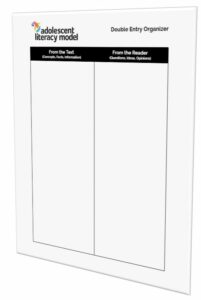STRATEGY FOCUS
Double Entry Organizer
PURPOSE
The Double Entry Organizer (DEO) is a strategy to promote active engagement during and after interaction with content. It is intended to provide scaffolding and guidance for students to take notes and reflect on those notes, generating questions about the content, ideas, connections, and opinions. In addition, students can use the questions generated from the DEO to discuss the lesson’s content in small or large groups and can maintain completed organizers as reference for independent study.

PROCESS
- Provide the DEO to students or have them create their own on a sheet of paper folded lengthwise in the middle.
- Clarify for students the difference between information from the text/content and student responses to the text/content.
- Show completed DEO models to students with examples of different ways to fill it out (e.g. bullets, drawings, questions, reflective notes, etc.)
- Have students read the assigned text and add entries to the DEO at natural stopping places (so as to not interrupt the flow of reading).
- As students become more comfortable using the DEO, make blank copies available for them to use at any time.
PROCESS (Continued)
-
- As students learn to use the DEO, it is valuable to do think alouds with students modeling how you might capture the notes from a text/lecture/video to provide students understanding of how they can capture what they are learning.
- This process is best accompanied with release of the think aloud process to include student sharing of what they captured on the organizer (during the process not just after).
- Stopping the reading/lesson at a prescribed amount of time or content (i.e. 5 minutes of reading or section 1) and having students share 1 important detail and how the student connected to it, can support the ‘I Do, You Help’ portion of the release
- This sharing can be further released by having student Pair Share what they added to the DEO during the last chunk of information. By doing this before doing a whole group share, students can refine their skills at identify key ideas and supporting details as well as the interactions they have with the content.
- As students’ progress in their use of the organizer, make blank copies regularly available for students to use at any time that they find the tool useful during and after interaction with content.
- To create ‘purpose’ for students to capture their thinking be sure the DEO provides a structure for the follow-up discussion/debrief of content.
- In small groups, have students identify the 3 most important details and at least three interactions with those details (having more interactions is more important than having more details because it honors a wide variety of connections while having students focus on the key details)
- During whole class discussion have students share their… questions/new vocabulary/connections to yesterday’s learning
- To further create engagement with the tool design purposeful interactions with already created DEOs (i.e. in small groups review the notes from a specific tex/video/day to identify the key important details or review a specific example for key characteristics)
- Work with students to create study guides based off of their DEOs to develop their capacity to ‘study’ from their own notes rather than provide them a completed unit study guide. This process develops their capacity to identify critical material and provides you a formative assessment for content that is identified by all or most of the students as critical and content this is not.
- To create ‘purpose’ for students to capture their thinking be sure the DEO provides a structure for the follow-up discussion/debrief of content.
PROBING QUESTIONS
CONSIDERATIONS
- What questions did you record early in your reading that still are not answered?
- Identify a section of text that was particularly difficult for you and discuss with a partner how the DEO helped you work through it.
- What kind of responses in your DEO were most helpful to you in processing and remembering what you read?
- The DEO can be paired with strategies from other Literacy Subdomains to enhance student comprehension. For example, students may use DEO in preparation for Academic Dialogue strategies such as Block Party, It Says-I Say-And So, or Paired Verbal Fluency.
- The DEO does not need to be collected for a grade, but the teacher may do spot checks to ensure students are capturing enough information from the text.
- Encourage students to add to their DEO as they continue reading or reread the text and have new realizations or find answers to previous questions.
- In addition to using the DEO during reading, students can also use the DEO as a note taking tool during listening or viewing activities.
CONTENT APPLICATIONS
![]() SCIENCE
SCIENCE
Students complete a DEO as they read a scientific article about a recent natural disaster. Students record information that will help them answer the lesson question (or their own question) and they record questions that arise as they read.

VISUAL & PERFORMING ARTS
Students use a DEO while reading a play review written by a theater critic. They use the information on the DEO to engage in an Academic Dialogue strategy to discuss their agreement or disagreement with the critic’s opinion on the play.
 ENGLISH
ENGLISH
LANGUAGE ARTS
Predetermine concepts, facts, and information you want students to pay close attention to when reading a text for the left side of the DEO. Ask open ended questions for the right side for students to write ideas and connections. As students read, they complete the organizer.
![]()
MATHEMATICS
Students solve a problem on the left side and on the right record the steps of their thinking to solve it. They also compare/contrast example problems to determine which steps to use first and why.
![]()
SOCIAL STUDIES
Students use a DEO as they read a primary source document from the Depression Era.
![]()
CAREER & TECHNICAL EDUCATION
Students in the Education Pathway use a DEO as they read The Montessori Method by Maria Montessori, especially focusing on Montessori methods that they may have experienced as a student.
![]()
WORLD LANGUAGES
As students read a passage in the target language, they write down central ideas and details on the left hand side, and capture connections, questions, new vocabulary on the right hand side.
 HEALTH & PHYSICAL EDUCATION
HEALTH & PHYSICAL EDUCATION
As students study impacts on personal health (i.e. environmental, family), they capture connections to current events, questions to ask family members and/or reflections on their own behaviors.
Reproducible
Sources
Billmeyer, R. and Barton, M. L. 1998. Teaching reading in the content areas: If not me, then who? 2nd Edition. Mid-continent Regional Educational Laboratory.
Double-entry journals. AdLit. (n.d.). Retrieved February 4, 2022, from https://www.adlit.org/in-the-classroom/strategies/double-entry-journals
Pauk, Walter; Owens, Ross J. Q. (2010). How to Study in College (10 ed.). Boston, MA: Wadsworth. ISBN 978-1-4390-8446-5. Chapter 10: “The Cornell System: Take Effective Notes”, pp. 235-277

